About the tactical advantage of speed in a naval battle, or Two knots for "crossing T"
In other words, it was believed that with a somewhat comparable level of artillery preparation of the opposing squadrons, the holding of a “crossing T” guaranteed the winning of a naval battle.
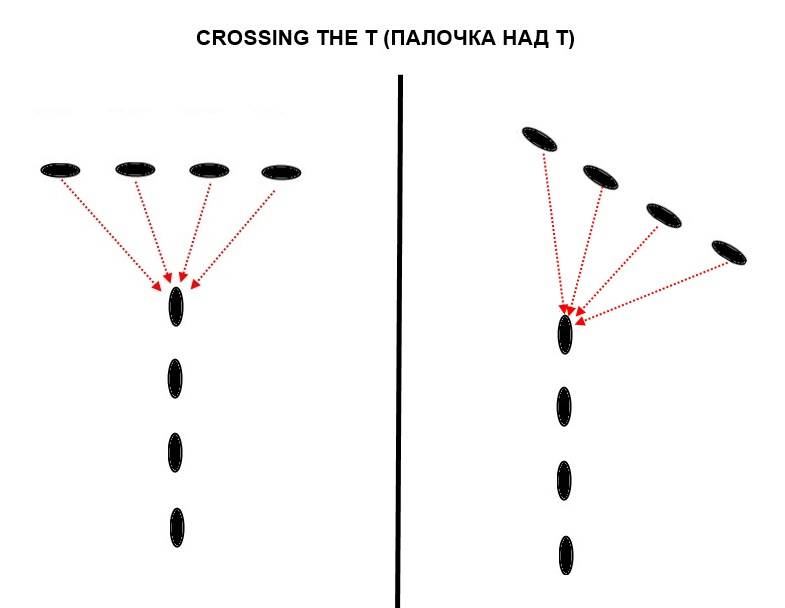
Of course, the admirals tried to exhibit “crossing T” to their “opponents” in peacetime, during training maneuvers. And here, according to the author, the teachings of the British are very revealing fleetheld in 1901-1903 For three consecutive years, Royal Navy squadrons converged in “battle”, and all three times one of the squadrons had a slight superiority in speed - within 2 knots. At the same time, all three times the slow-moving squadron was losing with a bang, as she was given the “crossing T”. Of course, one can assume that the matter was in the commanders, but this is extremely doubtful. So, the admiral, who commanded the “high-speed” squadron in 1901, achieved victory for her, but in 1903, being appointed to lead the “slow-moving”, he lost maneuvers near the Azores.
From the foregoing, of course, the conclusions suggest themselves that winning around the 2 node gave a tremendous tactical advantage to the squadron that possessed it. With some correct actions by the commander of the fleet squadron, the slower one had no chance of avoiding the “crossing T”.
However, many lovers of military stories This thesis seemed wrong, and here's why. The fact is that there is a certain position of the squadron, at which the “two-node” speed gain does not allow the more high-speed squadron to set “crossing T”. Suppose two fighting squadrons are "right fight", that is, fighting in the wake columns, heading in one direction. Naturally, the more high-speed squadron will gradually overtake the enemy’s convoy, and its commander will have a desire, turning against the enemy’s course, to set him “crossing T”. Let's show it on a simple scheme.
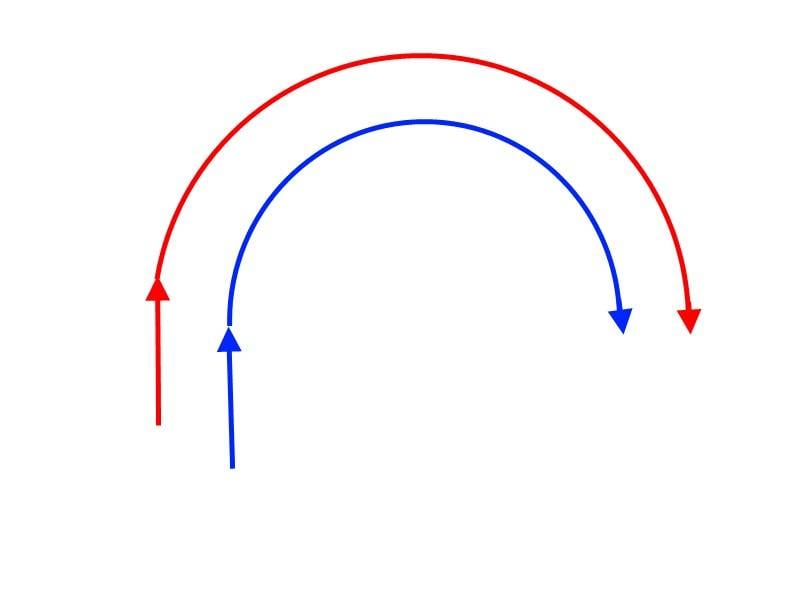
Suppose a high-speed squadron of the “Reds” is fighting with a slow-moving squadron of the “Blue”. The admiral of the "blue" sees that the "red" turn in order to put him "crossing T". What can he oppose to his opponent? Elementary - to repeat his own maneuver. In other words, when the "red" will go to cut the "blue", the latter turn in the same direction. If the "red", seeing that the enemy turns away from them, again screwed him to intercept, then you will need to turn away from them again. In this case, the squadron will go as if in two circles, one of which is inside the other. And the more high-speed "red" will have to go on the outer circle, and the less high-speed "blue" - on the inside.
But from the school course of geometry we know that the circumference (perimeter) of the inner circle will be substantially less than the outer one. Accordingly, the advantage of the speed of the “red” squadron will be wasted on the fact that during the same period of time it will have to travel a greater distance than the “blue” - of course, under such conditions no “crossing T” will be possible.
And so, on the basis of this “maneuver of the inner circle”, an assumption has arisen that in reality the speed advantage on 15-20% is completely insignificant, and can easily be parried by correct maneuvering of a slow-moving squadron.
So what is this - 2 node advantages of the pre-dreadnought squadrons of the era of the Russian-Japanese war? Pledge of victory, or purely theoretical, but nothing significant in practice advantage? Let's try to figure it out.
Baseline data, or such complex simple maneuvers
For any simulation, source data is needed, which we will now denote. The author will consider the possibilities of using “crossing T” on the example of maneuvering 2 squadrons, each of which is composed of 12 armored ships. Suppose also that all ships of both squadrons have the same length in 120 m. Each, and the intervals between them are standard, and make up the 2 cable (in the same cable - 185,2 m). Consequently, the length of the column of each squadron from the flagship stem to the secondary battleship of the closing battleship will be about 30 cables. The speed of the “red squadron” we will install 15 knots: “blue” will have less nodes on 2, that is 13 knots. And now let's stop for a short while, because there is one, extremely important “but!”, Which should be specially mentioned.
Any squadron maneuver can begin only after the completion of the previous one.
Why is that? Let us explain by the example of the simplest seemingly maneuver - turning the squadron sequentially on 8 points, or on 90 degrees. It would seem, well, what is so complicated about this - the lead ship, having raised the corresponding signal, turns to 90 hail. Behind him, the remaining ships of the column repeat the maneuver ... Elementary action, available not to the commander of the ship, but to the midshipman of the 1 course! Well, maybe not the midshipman, but the midshipman will certainly do it, right?
Alas, absolutely not.
There is such a thing as the diameter of the tactical circulation or the distance along the normal between the lines of reverse courses after turning the ship to the first 180 degrees.
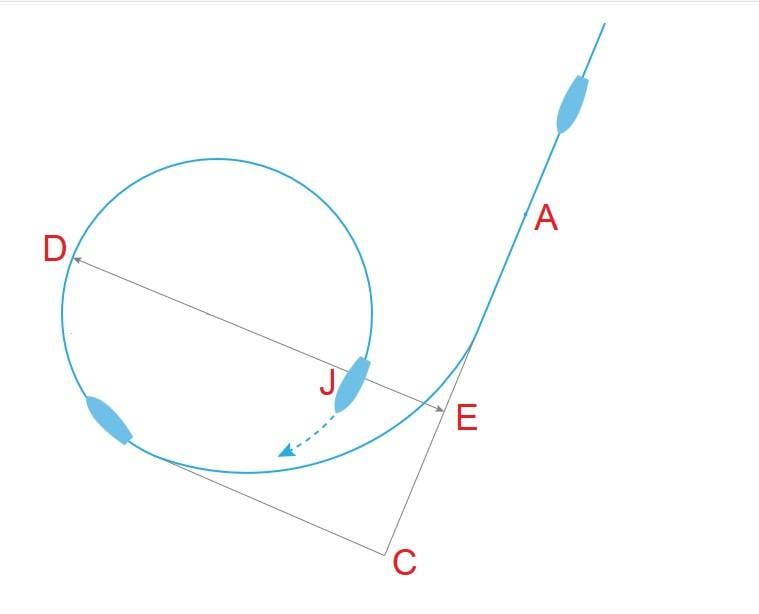
So, for each ship of the squadron, the next with the same speed, the diameter of the circulation is its own, individual, and it depends on many things - it is the ratio of length to width, the rudder area, its angle of transfer, the shape of the hull, as well as external factors such as excitement , current and wind. In theory, for ships of the same type, the diameter of the circulation should be almost the same, but in practice this does not always happen. Unfortunately, this indicator is usually considered unimportant and rarely listed in reference books, so there is not as much data as we would like.
It is known that the higher the speed of the ship, the smaller the diameter of the circulation. For example, the American battleship "Iowa" 2,712 cab. on starboard at 10-nodal speed and 1,923 cab. on the left side at 14-nodal speed. But here, in the same type of French battleships of the type “Devastason”, it turned out the opposite: “Devastason” with 9,5-bonds described a circle with radius 725 m, while “Curbet” at speed 8. had only 600 m. It is clear that at a speed of 9,5 knots. the circulation of “Kurbe” would be even more different from “Devastasion”.
Or take, for example, the Japanese battleships Yashima and Fuji. Ships are considered to be of the same type, but at the same time they had differences in the underwater part. The fact is that these ships were built at different enterprises, and the designer Philip Watts, adapting the blueprints to the capabilities of the Armstrong plant, cut off the deadwood from the future Yashima and also installed a steering wheel. As a result of these actions, Yassima received an extremely small circulation diameter for ships of its class, while at Fuji it was closer to the average values of the British battleships.
In addition to the hull design, the speed of the rudder transfer, which could be different from different drives, also influenced the circulation - for example, on the Slava battleship, you could put the steering wheel straight from the 18 with the steam drive and 28 with electric. Of great importance was the windage of the surface part - in the same "Glory" the diameter of the circulation depending on the strength of the wind (from 1 to 6 points) changed from 3,25 to 4,05 of cables.
Perhaps we should say that the circulation diameters of the battleships of that period averaged from 2 to 3,8 cables, but in some cases they could be smaller or larger. By the way, it's funny that the diameter of the circulation could differ even in one ship, depending on which board it turns: in the armored cruiser “Men” (1895), at the speed of 12 nodes it was 2,35 cab. on starboard and 2,21 cab. on the left.
In addition to the difference in the diameter of the circulation, there is also a difference in speed: ships on circulation may lose, according to various data, up to 30-35% speed, but, again, it depends on their individual characteristics.
And so, by virtue of the foregoing, even the usual turn of the squadron on 90 hail. becomes a kind of circus act. Ships go to the wake, but it is not so easy to catch the point at which the flagship will begin to unfold, and yet it is necessary to make a correction for the difference in the diameter of the circulations, which is not constant and varies for many reasons. It is not surprising, therefore, that when the ship going into the formation completes the turn (that is, in our example, changes course to 90 hail), it will find that it no longer goes to the wake of the matelot ahead of it, but to the right or left, with the prescribed interval between the ships, of course, broken. Accordingly, the ship needs time for alignment in the ranks - that is, to return to the wake and level the set interval. That is, even two ships will experience some difficulties with rebuilding, and the maneuver of an entire squadron can be complicated by what can be called a “dead phone”. The fact is that the ship following the flagship makes a turn with an error due to its circulation diameter and so on, but the battleship following it cannot orient itself to the “reference” course of the flagship, but follows the “wrong” trajectory after the second one. Thus, the error-deviation from the flagship rate for ships at the end of the system will gradually accumulate, and may increase significantly.
That is why the squadrons need joint maneuvering, the ships, their components, must be floated. The ability to maneuver in those days did not exist by itself, but in conjunction with specific ships. That is, the battleship, who knew how to keep the line in one squadron, being transferred to another, will be constantly beaten out at first. And not at all because his commander does not know how to maneuver, but because he needs time to get used to the peculiarities of maneuvering the ships of his new squadron, to adapt to their circulation diameters, etc. A little distracted from the topic, we note that it was this that became a problem when 3-s Pacific squadron joined the 2-th. Rear Admiral N.I. Nebogatov could train his crews as much as he wanted and hone maneuvering in his squadron to shine, but after rejoining the squadron he still needed to sail with the ships of Z.P. Rozhdestvensky.
All those interested in the history of steam fleets know the extremely important role played by the formation in battle. And you need to understand that anyone, even the simplest maneuver, essentially destroyed the established structure of warships, so they needed some time to restore it. That is why starting a new maneuver, without completing the previous one, was extremely dangerous — in this way, the squadron’s combat order could be completely upset. And that is why the admirals of those years began the next maneuver only at the end of the previous one. Well, when they did not do this ... I recall that at the 1901 maneuvers, the relatively low-speed British squadron under the command of Rear Admiral Noel, being attacked by a more fast-moving adversary, did not have time to reorganize into battle order before she was set to "crossing T" . As follows from the Russian descriptions of this episode, Noel tried to somehow remedy the situation, ordering to increase the course. But the result was not even a new maneuver, but a simple increase in speed in conditions when the ships did not complete the rebuilding, the fact that the structure of the British battleships simply collapsed. I recall that we are talking about British ships, whose sailors were traditionally strong in maneuvering.
For our example, for both squadrons we take the size of the diameter of the 2,5 cable circulation, the turning time for 90 degrees - 1 minutes and 180 degrees. - 2 minutes.
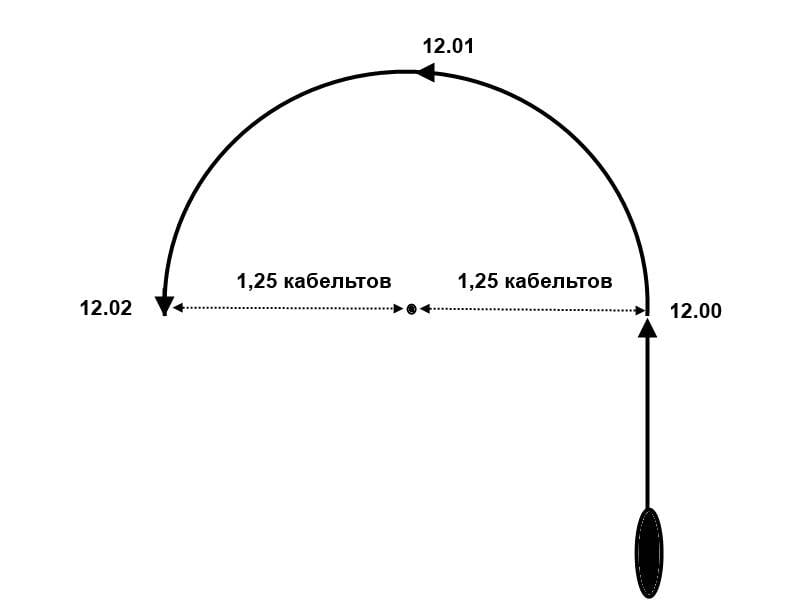
This will be a known simplification, since a slower squadron will have a larger circulation diameter and will perform it more slowly than a high-speed one. We will make another simplification - we will not calculate the length of the arc exactly every time, and the circulation time - in cases when it is closer to 90 hail, we will accept the circulation time in a minute, when closer to 180 hail. - for 2 minutes. This is necessary in order not to complicate the calculations beyond measure.
And now - "crossing T"
As we said above, the “Maneuver of the inner circle” guaranteed to protect the slower squadron from “crossing T”. However, supporters of this maneuver overlook one extremely important nuance: in order for this maneuver to work, you must somehow "convince" the commander of the more high-speed squadron to line up in a parallel column of the "low-speed" squadron - and from this position try to put the "slow-moving" "Crossing T".
In other words, the “inner circle” can really help the low-speed squadron, but only if the high-speed squadron, instead of without further ado, set the “crossing T” to its low-speed opponent right away, for some reason it will tie the right one fighting in the wake of the column, and only after that will try to set "crossing T". But why the high-speed squadron do this?
Absolutely no need. Thus, our tactical task for the parties comes down to the following: the main task of low-speed "blue" is to force our opponent to enter the "right fight" in parallel columns. If they succeeded - we believe that the “blue” achieved victory, because in this case the high-speed squadron will really lose the opportunity to set “crossing T”. Accordingly, the task of the high-speed “red” squadron will be to set up “crossing T” and avoid entering the “right fight”.
Of course, the more high-speed squadron will have a definite advantage in taking the most advantageous position for itself. But she herself does not need it, because in order to put the squadron of the "blue" in an impossible situation, it suffices to make only one, rather simple maneuver.
For this “red” it was enough to get close to the enemy squadron by about 40 cable, and then turn it so as to cross the course of the “blue” angles 45 deg. left or right.
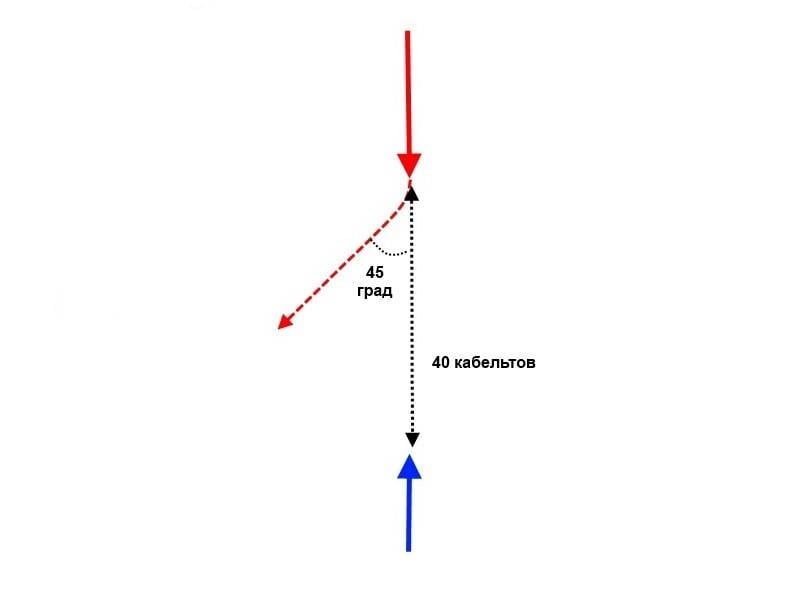
After that, the “blue”, according to the author, will not have a single chance to avoid “crossing T”.
Why is that? Let's look at all the options for admiral "blue", which he can take in response to such maneuvering "red". In essence, all of his possible maneuvers are reduced to performing turns or turns sequentially, or “all at once”. We first analyze the turns turns sequentially.
Take for example the situation when the squadrons go on opposite courses, and then the red ones turn to 4 Rumba (45 degrees) to the left, as shown in the diagram above. "Blue", of course, free to choose any direction from their existing 360 degrees.
What happens if an admiral of the “blue” dares to go straight without changing the course? Suppose (here and in all other variants) that the squadron convergence on 40 cable occurred in 12.00. Then the “reds” take a turn, which takes away from them a minute of time, so their flagship in 12.01 rests on a new course. After about 9 and a half minutes, the squadron of the “blue” will receive the classic “crossing T” - its flagship will be hit by dagger fire from the 9 wake column of the “red” ships, at a distance from 11 to 16,5 cables. At first glance, the flagship “Reds” are also in danger, and this is actually the case, but still the 9 of the enemy ships closest to it can shoot at it from a distance from 16,5 to 28,5 cables, but still its position and not so close dangerous as the flagship "blue". The squadron position is shown in Figure 1 in the following diagram.
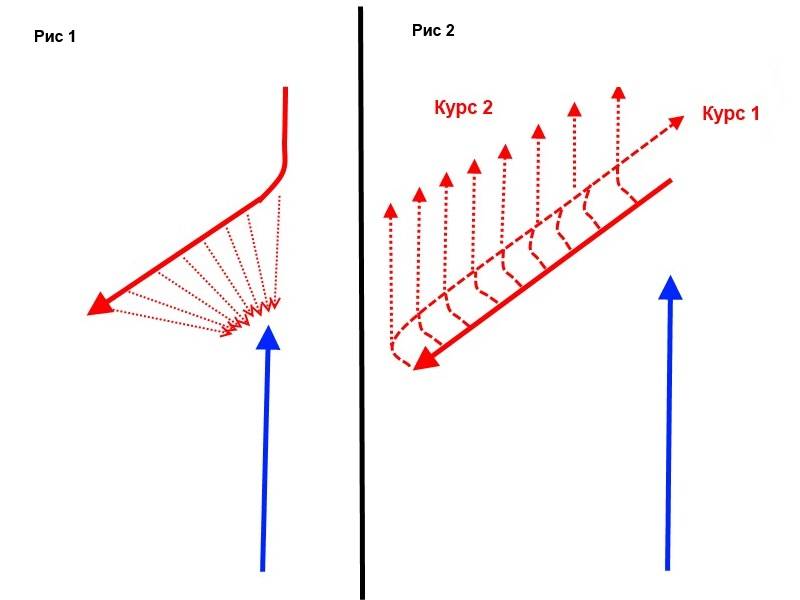
At the same time, the "red" will complete a turn in 12.13, and by this time the distance from the flagship of the "red" to the enemy ship nearest to it will exceed 21 cables, while the blue flagship will be replaced by defeating 5-10 cables.
What's next? It is safe to say that with such a maneuver the “blue” head of their columns will be broken, and the “red ones” can simply turn “all at once” to 180 degrees, in order to continue their wand over T. But you can not do this, turning "all of a sudden" on a course parallel to the squadron of the "blue", and smashing them, retreating in the structure of the ledge - in this case, of course, "crossing T" will also take place.
So, to move the same course for the "blue" is meaningless. But maybe it is worth trying to cut across the "red"?
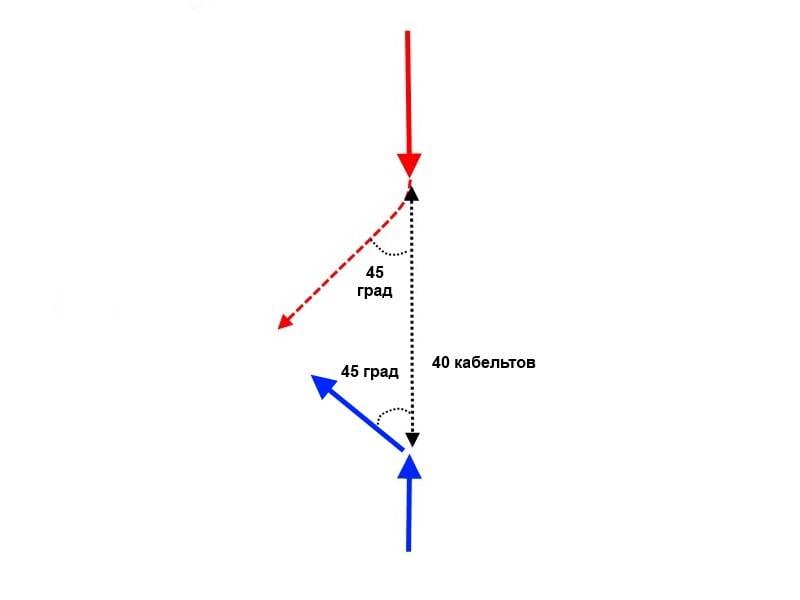
This does not help - here everything is decided by the very 2 node superiority in speed. In this case, the task is very simple, and really comes down to high school geometry. We have a rectangular isosceles triangle, in which the hypotenuse is the distance between the squadrons, and the legs are the courses of the squadrons after turning. Following these courses, the squadrons will converge at an angle 90 hail. If the “blue” and “red” turned at the same time, the “red” would still be ahead of the “blue” ones by about 1,5 minutes, that is, the “red” flagship would cross the “blue” course around the 3,8 cable in front of the stem. This is too little to talk about “crossing T”, there would be a dump, but the problem is that the “blue” will not be able to change the course at the same time as the “red”.
The admiral of the "blue" seeing that the red leader is turning somewhere, will have to wait until he lies down on a new course, determine this new course, decide on a counter-maneuver, give the command to execute, and yet to fulfill ... There will be more time lost on it - and these two terms in the sum will just lead to a delay, which will allow the “red” to put a “crossing T”, cutting the course of the “blue” ones into approximately 8-10 cables. And again - if the “blue” and “red” had equal speed, then this number would not have passed. Yes, the "red", taking advantage of the fact that the "blue" began to maneuver later, would have overtaken the latter, but only slightly, and instead of "crossing T" you will get a dump. But the combination of two factors - the slower speed of the "blue" ones and the fact that they are the second to start the maneuver - leads to the fact that the "crossing T" will be set.
But why in our tactical task "red" always maneuvering first? The answer is very simple - the "blue" can not afford this. Going to 13 nodes, they need almost 14 minutes to complete the maneuver, and “red” just 12. Thus, the admiral of the "red" will always have time to consider the maneuver of the "blue", and perform their own counter-maneuver, and both squadrons will finish their maneuvers almost simultaneously. That is, a more high-speed squadron, if given the right of the second move, will get just an enchanting advantage.
For example, if the "blue" first try to go to 45 hail. from the course of the “red” squadron, then the reds will immediately “cut” the course, and their speed will be just enough to set the classic “crossing T”
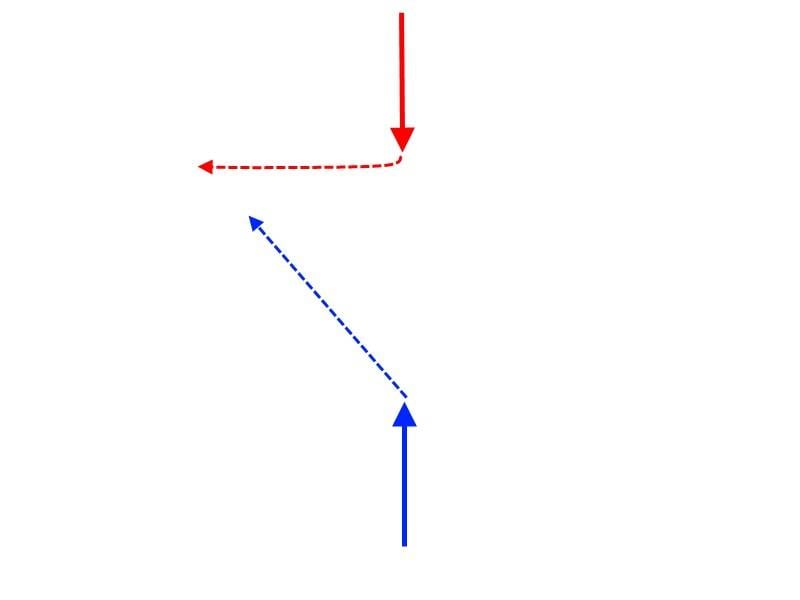
And the "blue" can not do anything, because by the time they complete the turn, the "crossing T" will already be set.
Well, okay, it’s impossible to go "red", but what else can you do? Maybe try to lie down on a course parallel to the red in order to go with them in one direction or to disperse countercourse? Well, let us consider every minute a situation in which the "blue" turn around and fall on a parallel course.
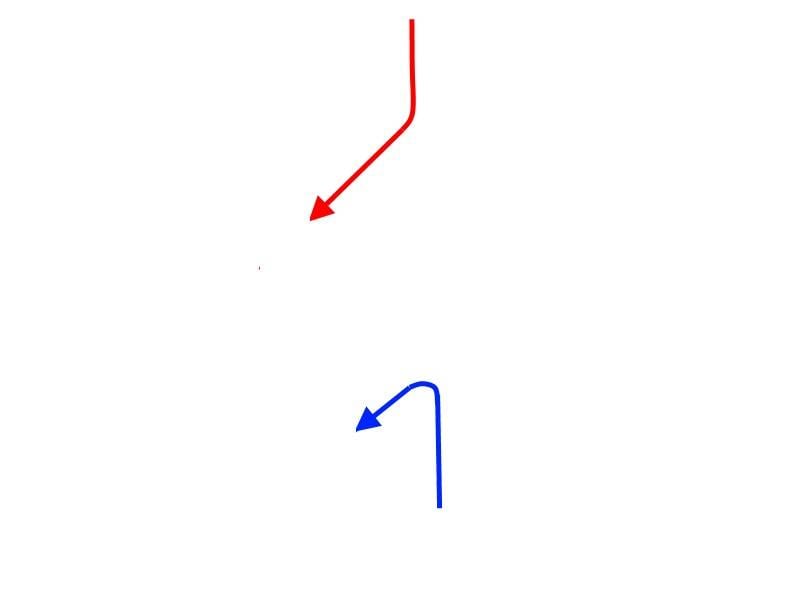
So, in 12.00, the distance between opponents of the 40 cable and the "red" starts turning. In 12.01, their flagship rests on a new course, shifting as a result of circulation by approximately 1,25 cable from the starting point of the turn, and the squadron of blue, following the previous course, passed almost 2,17 cable. Suppose that the "blue" have a fantastic reaction and begin to turn immediately after the red leader completed the turn, although this, of course, is unrealistic. But let's say.
At this moment (12.01) the distance between the pivot points of the squadron is a little more than 36 cable. In the subsequent 2 minutes, the “red” ones continue to perform the maneuver, that is, their flagship, describing a semicircle, returns to the point where it began to turn, but is now on 2 cable closer to the “red” (or further, if it turns to the right) . Thus, the "blue" begin to move on a new course with at least a two-minute delay relative to the "red". Since “red” requires the 12 mines to complete the maneuver since their flagship is launched, and the “blue” one is almost 14, the “red” ones complete the maneuver in 12.13, and the “blue” remains almost 4 minutes. It turns out that the "red" can start any maneuver, while the "blue" can begin to react only after 4 minutes, when the rebuilding is completed.
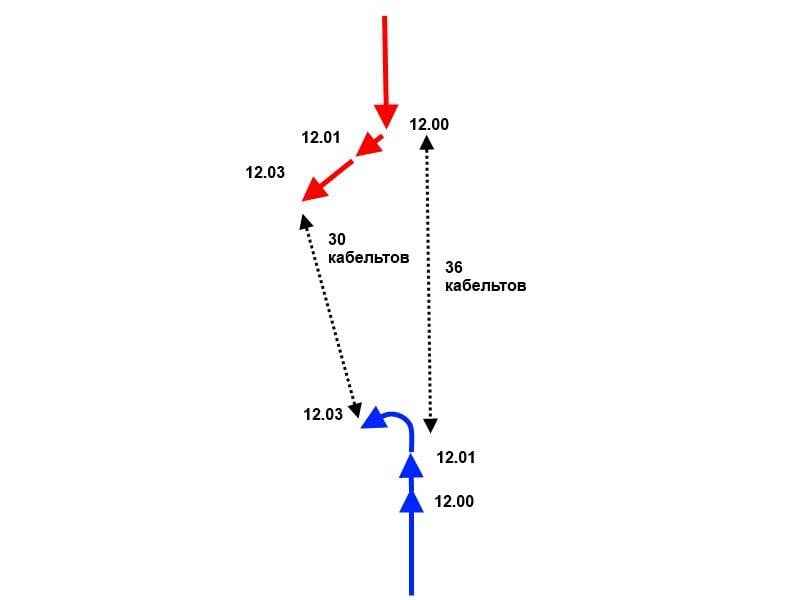
It should be noted that during the whole time of the “blue” maneuver, the “red” have a fire advantage. Considering that the battleship will start shooting, after it has fallen on the new course, the 12.03 will be able to "work" the 3 of the lead ships on 12's battleship, and only the blue flagship will respond to them. In the future, of course, the remaining ships will turn around and engage in battle, but by the time the “red” deployment is completed, they will have 8 ships fired, and the blue ones will only have XNUMX. That is, of course, at this stage there is no “crossing T” yet, but the beginning of the maneuver is unsuccessful for the “blue” ones.
And then the “reds” can turn to the left successively (Figure 1 in the diagram below) in order to set the “crossing T” for the end ships of the column.
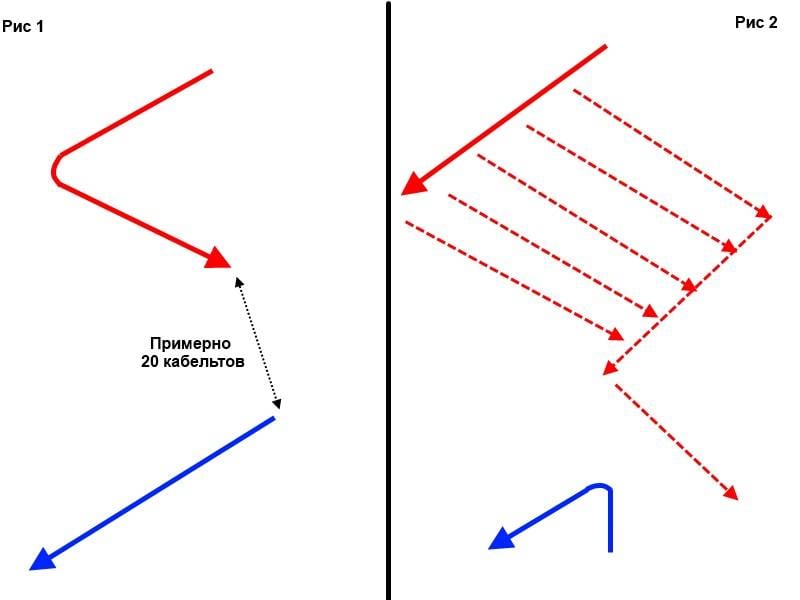
But then they themselves will fall into an unpleasant position for some time, since their turned ships will interfere with the rest of the battlefield. It would be wiser to do a little more cunning, making the turn "all of a sudden", as shown in Figure 2. By the time the “blue ones” are finally rebuilt, the distance between the closest ships will not exceed the 20 cables, and soon the squadron of the “reds” will hit the sharp course angles of the “blue” so that the effectiveness of artillery fire will weaken on both sides. And after that, "cut the tail" column "blue" (Figure 2)
In this case, "blue" in any case, nothing remains but to leave, trying to break the distance from the red and hoping for a miracle. Theoretically, they could try to turn around "all at once", but in this position this maneuver does not give anything "blue".
Thus, we see that an attempt to lie on a parallel course and move in the same direction with the "red" ones does not save the "blue" from defeat. Well, what happens if the "blue" in the battle stitch try to go to the countercourse? Yes, all the same, the situation is almost a mirror. At first, the “red” and “blue” ones will really disperse on countercourses, but the rebuilding of the “red” ones will finish faster. As a result, they are exactly the same, turning “everything suddenly”, will be able to first get close to the “Blue” end ships, and then set them to “crossing T”.
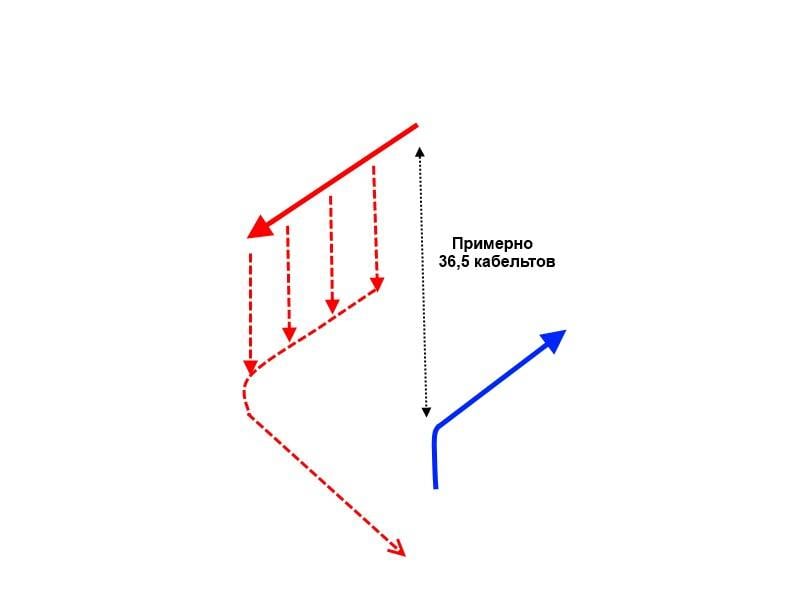
What other options are possible for the "blue"? Run away from the "red" squadron? But such a maneuver of evasion, he performed at least a turn consistently, even if all of a sudden, still leads to the fact that at the end of the column "blue" will hang a squadron of "red" built by a ledge, which means "crossing T" is inevitable.
But maybe the “blue” should try to “play” on the same properties of the triangle, which in all the above examples play into the hand of “red”? If in response to the rotation of the “red” on 45 degrees, and to tighten in the same direction, but not on 45 degrees, but on all 90? In this case, the admiral of the "blue" will lead the squadron entrusted to him as if along the leg of a right triangle, while the "red" will follow his hypotenuse. In this case, the "red" will have to go significantly more distance than the "blue" and their superiority in speed will be neutralized.
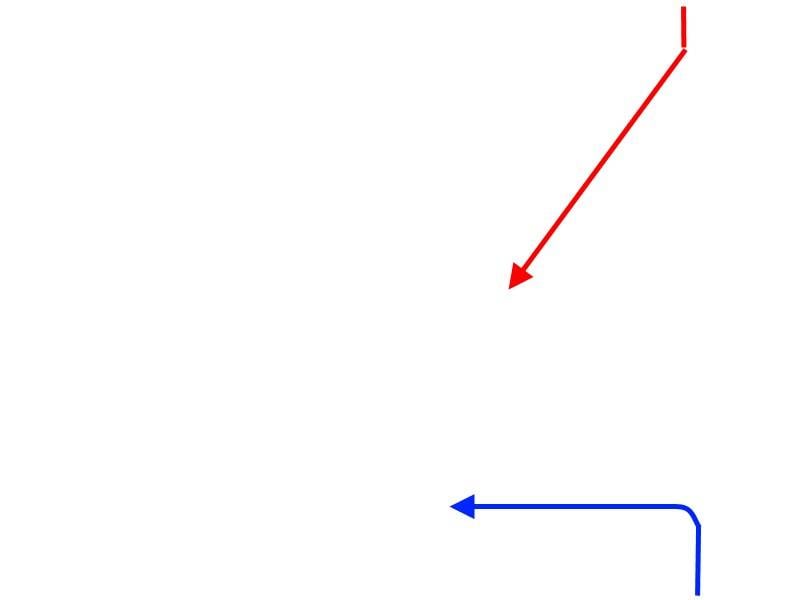
All this is true, but the commander of the “Reds” has a quite elegant counter-maneuver.
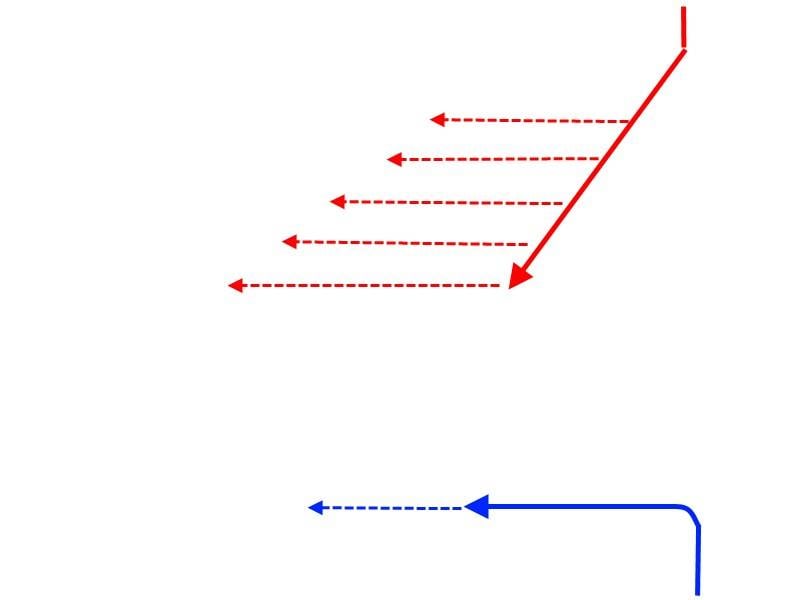
Turning "all at once" and moving along the course of the "blue" will bring the formation of the ledge of the "red" to the head of their columns, and Carthage will be ... eghkm, "crossing T" will be delivered.
All other turns (yet they can go in any degree from 360) are a special case of one of the above maneuvers.
Conclusions
So, we have considered all the basic maneuvers of the “blue” ones, but in no case will they succeed. The advantage in the 2 node seems small for the era of the Pre-Susim armored fleets, but in reality it did provide those who had a decisive advantage for two main reasons.
First, it gave "the right of the first turn", that is, it passed the initiative to the high-speed squadron. At a distance of the 40-45 cable of a low-speed squadron, it would be extremely dangerous to start the maneuver first, since its high-speed adversary had the opportunity to immediately “punish” such an initiative by putting a “crossing T” or at least taking a position to display it.
The second reason followed from the first — since the slow-moving squadron could only respond to the actions of its high-speed “opponent”, it ended its counter-maneuver much later than the enemy. The backlog consisted of the loss of time to assess the enemy’s maneuver and more time to perform the maneuver than that required by the more rapid squadron. Thus, whatever the counter-maneuver the slow-moving squadron started, it completed it much later than the fleet finished its, which, again, gave the commander of the latter an indisputable advantage.
Two "Why?" and one observation
In conclusion, this article would like to mention a couple of nuances. The maneuver schemes presented by the author, which must be performed in “red” in order to perform the “crossing T”, are rather complicated. We are talking about turns "all of a sudden", after the execution of which the flagship is at the end of the system, and the terminal ship must lead a squadron, making further turns "all of a sudden" or turns sequentially. According to the author’s deep conviction, in real life, such complicated maneuvers were not required for placing the “crossing T”. Their need in our example is due solely to preferential assumptions for the “blue” in the accepted rules of our tactical game. As a matter of fact, all the above descriptions are not a “textbook for the admiral”, but rather a justification for the fact that placing a “crossing T” squadron, which has superiority in speed in the 2 node, is geometrically possible.
Why in the battle at Shantung X. Togo, having superiority even more than in the 2 node, did not put a “crossing T”?
The answer is very simple - excessive caution of the Japanese admiral. Still, in order to place a “crossing T”, it was necessary to energetically move closer to the enemy and maneuver at a relatively short distance from him, and X. Togo did not dare to do so in the first phase of the battle.
And finally, why in the interval between the world wars the British came to the conclusion that the superiority in speed on 10% does not give the squadron possessing it any tactical advantages, which was the reason for lowering the speed of battleships such as "King George V"? The answer is very simple - with the advent of the dreadnought era, the distances of artillery combat increased significantly, and convergence on the 40-50 cable with subsequent dashing maneuvers became impossible. Well, while maneuvering on 70 cables and above, the 10-percentage increase in speed really did not give any advantage.
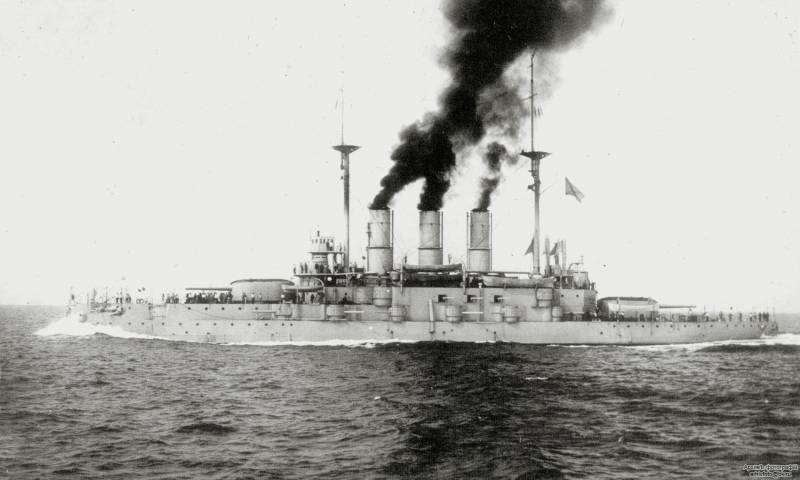
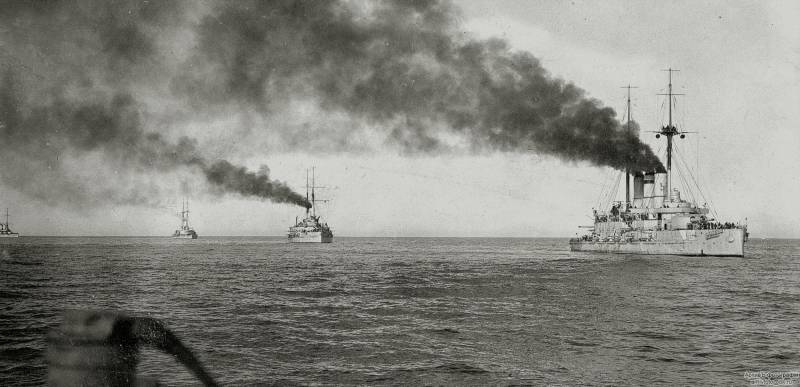
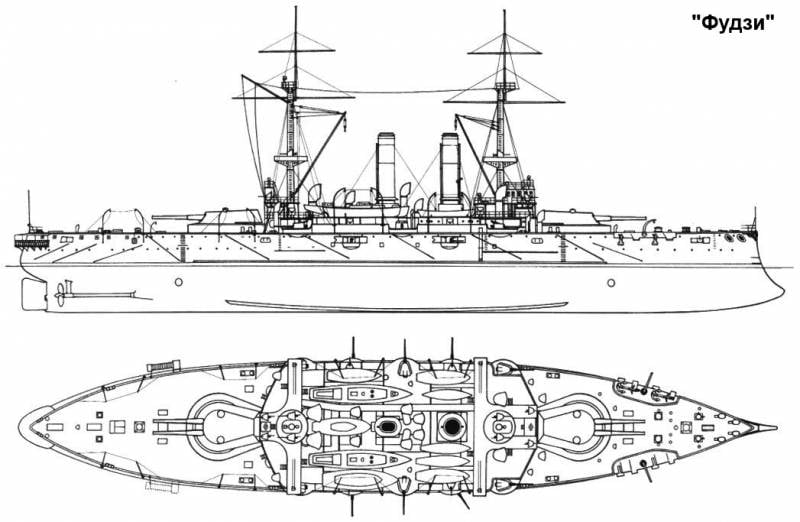
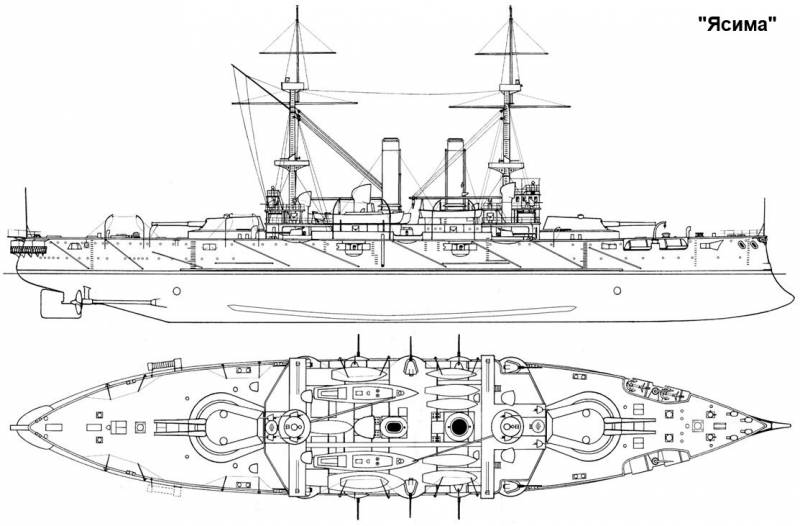
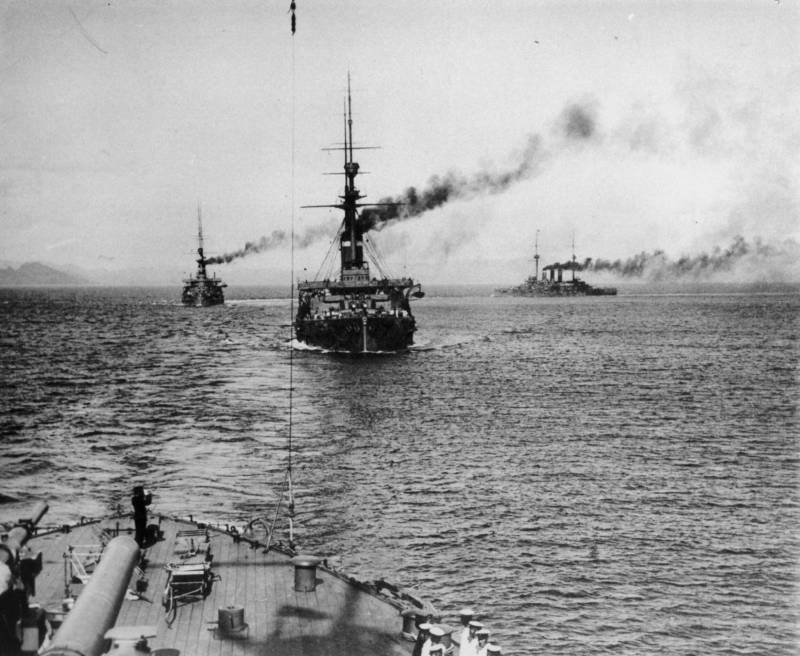
Information